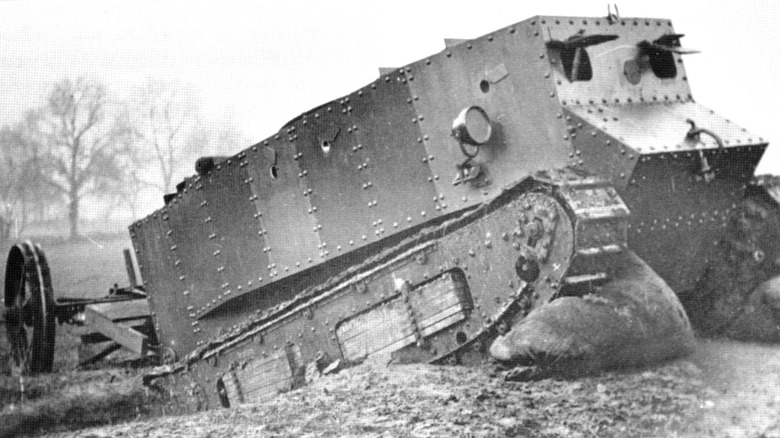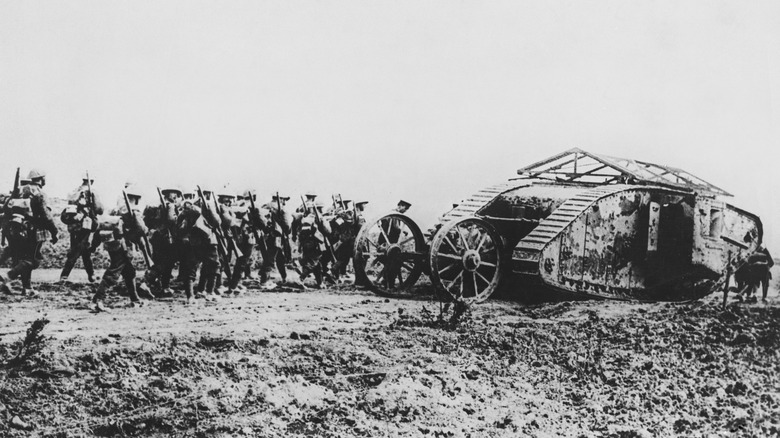History Of The First Ever Tank: Little Willie
The first World War started in July 1914, and by 1915, front-line advancement had ground to a halt and thus began the war's slog into a stalemate. Bloody trench warfare locked the Western Front in place, with both sides constantly losing soldiers to what, in effect, was a meat grinder.
The front stretched from the Belgian coast, through France, to the Swiss border, with each side typically comprised of three lines of zigzagging trenches. More in some cases. The space between enemy lines was referred to as No Man's Land, a barren, cratered, swath that meant near-certain death for anyone who tried to cross it.
The trenches could be as close as 50 yards or as far away as a mile, according to the History Channel. Two more lines lay beyond, each placed several hundred yards apart. Both sides built an estimated 35,000 miles of trenches during the war. Barbed wire limited movement. Approximately 16.5 million people died, with nearly 10 million being military personnel.
This massive loss of life can be attributed to the invention of deadly offensive wartime technology, as World War I was the first battleground to use trench warfare and flamethrowers, machine guns, poison gas, and, of course, tanks.
[Featured Image by The Imperial War Museums via Wikimedia Commons | Cropped and scaled | CC BY Public Domain]
This wasn't just a water tank
Despite the advent of never-before-seen weaponry in WWI, nothing could move the lines along the Western Front as the "hunker down" defensive tactics offset any offensive onslaught.
In February 1915, Winston Churchill, the First Lord of Admiralty at the time, commissioned the "Landships Committee" to create an armored tracked vehicle for land use. Interestingly, the term "landship" was derived from "battleship" due to apparent parallels. British Army Col. Ernest Swinton and Secretary of the Committee for Imperial Defense William Hankey came up with the concept of taking armored vehicles and fitting them with rotating belted tracks that could easily roll up and over any obstacle — including barbed wire.
Churchill agreed but wanted the project to be kept on the down-low. Even production workers doing the building were told the vehicles would be used as "water tanks" to carry sustenance to troops in the field. Thus, the name tank was born.
By July 1915, an early prototype was developed, which took the body of an existing armored car and slapped it on top of a Killen-Strait agricultural tractor. Several more tweaks were made, and by fall, the Armoured Car Division of the Royal Naval Air Service rolled out the Lincoln Machine, nicknamed "Little Willie" to poke fun at the German Imperial Crown Prince Wilhelm.
Little Willie led to Big Willie which led to the Mark I
"Little Willie" (aka the Lincoln Machine) was the creation of William Foster & Company of Lincoln. The 18-ton beast was nine feet tall, 26 feet long, and nine feet wide. It was powered by a rear-mounted 13-liter 6-cylinder 105 hp Daimler-Knight engine that was gravity-fed by three onboard fuel tanks (one inside and two outside).
It had a fixed, non-rotating turret that was supposed to be armed with a single forward-facing two-pound Vickers 40mm field gun (with 800 rounds) and six Madsen 7.7 mm (.303 caliber) machine guns placed around the other three sides. Little Willie wasn't armored; 10 mm thick boilerplate was riveted to the frame instead.
However, initial testing at the Wilson-Tritton track at Burton Park in Lincoln proved unsuccessful. For starters, "Little Willie" was painfully slow, only capable of going two miles per hour across flat ground, which was slower than infantry troops could march. Forget about rough terrain. The Willie's tracks would get bogged down in the mud, and the armor plating was too thin. Additionally, it was prone to overheating, and perhaps the most significant issue was that it couldn't cross trenches, which was part and parcel of every WWI battlefield.
Its creation led to vast improvements in its second form, called the "Big Willie" (poking fun at Wilhelm's father), which addressed most of the issues from the littler version, including the ability to cross trenches successfully.
The British Army approved the design and ordered 100 "Big Willie" tanks, eventually becoming the British Mark I. That tank first entered combat at the Battle of Flers-Courcelette on September 15, 1916, and the rest, as they say, is history.

